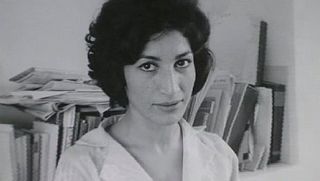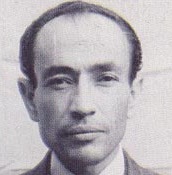
Nimā Yushij, also called Nimā (نیما), born Ali Esfandiāri, was an Iranian poet. He is famous for his style of poetry which he popularized, called she'r-e now, also known as She'r-e Nimaa'i in his honour after his death. He is considered as the father of modern Persian poetry.

Sohrab Sepehri was a notable Iranian poet and painter. He is considered to be one of the five most famous Iranian poets who have practiced modern poetry alongside Nima Youshij, Ahmad Shamlou, Mehdi Akhavan-Sales, and Forough Farrokhzad. Sepehri's poems have been translated into several languages, including English, French, Spanish, Italian and Lithuanian, Kurdish.

Ahmad Shamlou was an Iranian poet, writer, and journalist. Shamlou was arguably the most influential poet of modern Iran. His initial poetry was influenced by and in the tradition of Nima Youshij. In fact, Abdolali Dastgheib, Iranian literary critic, argues that Shamlou is one of the pioneers of modern Persian poetry and has had the greatest influence, after Nima, on Iranian poets of his era. Shamlou's poetry is complex, yet his imagery, which contributes significantly to the intensity of his poems, is accessible. As the base, he uses the traditional imagery familiar to his Iranian audience through the works of Persian masters like Hafez and Omar Khayyám. For infrastructure and impact, he uses a kind of everyday imagery in which personified oxymoronic elements are spiked with an unreal combination of the abstract and the concrete thus far unprecedented in Persian poetry, which distressed some of the admirers of more traditional poetry.

Forugh Farrokhzad was an influential Iranian poet and film director. She was a controversial modernist poet and an iconoclast, feminist author. Farrokhzad died at the age of 32 due to a car accident.

Mehdi Akhavān-Sāles, or Akhavān-Sāless, pen name Mim. Omid was a prominent Iranian poet. He is one of the pioneers of Free Verse in the Persian language.

Prince Iraj Mirza, son of prince Gholam-Hossein Mirza, was a famous Iranian poet. He was a modern poet and his works are associated with the criticism of traditions. He also made translation of literary works from French into Persian.

Nader Naderpour was an Iranian poet.

Javad Mojabi is an Iranian poet, writer, researcher, and literary and art critic. Mojabi is one of Iran's most prominent modern writers and poets, and has published over 50 literary works in various forms. He has also written hundreds of critical works and essays on art and culture in journals and magazines. He began writing poetry in the 1960s, along with short story writing and research on modern painting in Iran.

Manouchehr Atashi was a Persian poet, writer, and journalist.

Mehdi Hamidi Shirazi was an Iranian poet and university professor.
Leila Kasra also known as Hedieh, was a prominent Iranian contemporary poet and lyricist who has written lyrics for notable artists including Ebi, Dariush, Sattar, Vigen, Moein, Mahasti, Andy, Homeyra, Morteza, Hassan Shamaizadeh, Siavash Shams and many more. She was best known for writing more than 30 songs for Hayedeh.
Saleh Hosseini is a retired professor of literature, translator and critic.
Firouzeh Mizani is a contemporary Persian poet, writer, and journalist.
Kavoos Hasanli, born May 22, 1962 in Qanat-e-No in Iran, is poet, critic and professor at Shiraz University.

Abdolali Dastgheib is an Iranian literary critic, writer, translator and author of 66 books and numerous articles.
Shirazi Turk is a ghazal by the 14th-century Persian poet, Hāfez of Shiraz. It has been described as "the most familiar of Hafez's poems in the English-speaking world". It was the first poem of Hafez to appear in English, when William Jones made his paraphrase "A Persian Song" in 1771, based on a Latin version supplied by his friend Károly Reviczky. Edward Granville Browne wrote of this poem: "I cannot find so many English verse-renderings of any other of the odes of Ḥáfiẓ." It is the third poem in the collection of Hafez's poems, which are arranged alphabetically by their rhymes.
Jila (Zhila) Hosseini (1964–1996), poet, writer, researcher and radio announcer, was born on September 22, 1964, in Saqqez, eastern Kurdistan Rojhalat and was the first woman from Kurdistan to compose modern poems instead of classical poetry.











